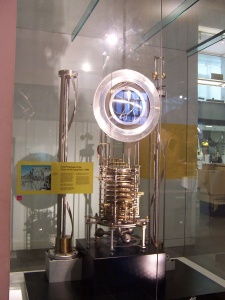How Do You Lubricate a 10,000 Year Clock?
By on May 17 2017

Time flies when you're busy contemplating the next ten millennia...
Time. It's on your side. It's changing. It's not in a bottle. We try to remember it, but as far as we know, we can't turn! turn! turn! it back. Things will get better with it. Time is tight.
Besides being a very popular topic among lyricists, time is the entirety of continued progress of events from the past through the present and to the future. Depending on your own outlook on life (and whether or not you have an interest in philosophy), time could mean everything or nothing at all.
Imagine what 10,000 years from now will look like.
For the most part, most evidence of timekeeping devices date back around 3500 years ago, or so. Ancient Egyptians used large obelisks to track the sun's movement. A number of civilizations, including Ancient Egyptians, Greeks, and the Zhou dynasty, utilized water clocks. Gear clocks didn't exist until the 11 th century, and these were water clocks. Mechanical clocks didn't flourish until the 14th century; spring powered clocks showed up in the 15th century and mechanical watched evolved in the 17th century.
Technology has exponentially changed over the past few decades, let alone few millennia. Given that most things don't seem to be built to last anymore, the idea of something lasting for 10 millennia is nearly impossible to grasp. But not for everyone.
The Clock of the Long Now
Ten thousand years ago, human population was only in the millions, rather than billions. Agriculture and animal domestication were only just beginning among certain groups. Industry didn't exist. Jobs and professions as we know them didn't exist. Time as we think of it today didn't exist not that long ago, at least.
In 1995, Danny Hillis, an engineer and mathematician, first wrote about his idea for a 10,000 Year Clock in WIRED magazine:
I want to build a clock that ticks once a year.
The century hand advances once every 100 years, and the cuckoo comes out on the millennium.
I want the cuckoo to come out every millennium for the next 10,000 years.
If I hurry I should finish the clock in time to see the cuckoo come out for the first time.
 Clock of the Long Now Prototype By Pkirlin at en.wikipedia, CC BY-SA 3.0,
Clock of the Long Now Prototype By Pkirlin at en.wikipedia, CC BY-SA 3.0,
Since the 90s, Hillis and others have been working to make the millennium clock a reality.
The work was mostly limited to the production of prototypes and the creation of a nonprofit, Long Now Foundation until Jeff Bezos stepped in.
The Amazon founder has put up $42 million and a portion of his property in Texas to build the first full-scale clock. The building of this clock will then contribute to the final design of the permanent clock to be built in Mount Washington in Nevada.
When contemplating the potential problems in building a 10,000 year clock, Hillis proposed these principles:
- The clock should accurately display the correct time for the next 10,000 years with only occasional maintenance.
- The clock should be simple enough that maintenance shouldn't be an issue (even with bronze-age technology).
- The operational principles of the clock should be easily determinable upon close inspection.
- Evolution and improvement of the clock should be possible no matter the point in time.
- Clock design should be scalable from table-top to monumental design. [source: Long Now Foundation]
If a clock chimes on the millennium and no one is around to hear it, does it make a sound?
Making a clock such as this is no easy task. It requires several computer scientists, engineers, and inventors. The project involves drilling 500 feet straight down into a mountain and constructing the clock deep inside the shaft. The clock's design involves massive metal gears, a huge stone weight, and a precise, titanium encasement inside a quartz box. The chosen materials were of particular importance because over time, metals can actually fuse together, making a clock like this inoperable.
The clock will run on a combination of solar power and hand-winding from visitors. Part of the clock is visible above ground, and this component is the thermal timekeeping device covered by sapphire glass. Sapphire glass is a synthetically produced crystal second only to diamond in hardness.
This clock is really going to be gigantic. To get a sense of how huge it's going to be, it involves three 700-pound, 8-foot-diameter stainless steel gears that support heavy stone weights. Smaller, titanium rollers mesh with the wheel's teeth to transfer power to other parts of the clock. Twenty wheels compose part of the clock's chime computer, which produces 3.65 million unique tunes that ring when people are there.
Keep it running smoothly
As any industrial savant knows, when you have a lot of wheels rolling, you need some high-quality lubricants to keep those gears from grinding. When your goal is to have a clock run for 10,000 years with minimal human interaction required, though, you can't exactly use standard lubricants. Besides, what if the future of lubricants is vastly different 5,000 years from now? How could the clock work if a major component doesn't exist anymore? Although we carry a large variety of premium, industrial lubricants at PSC, we don't have anything guaranteed to last for 10,000 years.

The answer for lubricating a 10,000 year clock actually lies in using no lubricants at all.
Uh...What?!
All the wheels in the Clock of the Long Now rotate on bearings made of zirconium nitride ceramic. These bearings were specially developed by Aerospace Engineers for use in satellites. When sending things up in space, you need bearings to roll without oil (spoiler alert: oil evaporates in space). Using these bearings in the clock solves the lubrication problem because they help minimize the friction between surface contact all without the oil component. You can think of zirconium nitride ceramic as a solid lubricant--it reduces friction and offers surface-to-surface protection without the need for a liquid oil medium.
The clock isn't finished yet, and we don't know when it will be complete--but it is going to take years, though.
If you're wondering why anyone would spend so much time, money, and resources on building a millennium clock, it's all about looking to the future and thinking outside of the present. The project aims to foster long-term thinking for all of mankind.
While we can't guarantee any of our industrial lubricants will last you a millennium (let alone 10!), we can provide you with the finest selection of automotive and industrial lubricants to keep your machinery running smoothly--at least for your lifetime.
Sources:
http://electronics.howstuffworks.com/gadgets/cloc...
https://en.wikipedia.org/wiki/History_of_timekeep...






